Leaves: petiole 2–5 mm; blade 25–65 × 10–20 mm, surfaces shiny. Floral tube 25–40 × 15–25 mm; sepals erect to recurved, thick, leathery; petals 15–25 × 10–20 mm; ovary proximal layer of 2 or 3 carpels with axile placentation, distal layer of ca. 5–7 carpels with parietal placentation. Berries reddish brown to yellow, globose, 5–12 cm diam. Seeds 7–12 mm. 2n = 14, 16, 18, 19 (cultivated).
Phenology: Flowering spring–fall.
Habitat: Old homesites.
Elevation: 400–1600 m.
Distribution
Introduced; Calif., Tex., s Europe, Asia, Africa, introduced also in Mexico, West Indies, Central America, South America.
Discussion
Punica granatum has been widely planted as an ornamental in the western and southwestern United States and has naturalized around old homesites. It has been cultivated for centuries in warm regions of the world, probably having originated in the Middle East in the area of modern Iran, Afghanistan, and Iraq. The seeds are eaten in salads and other dishes, especially in Mediterranean cuisines. Juice expressed from the fruit rind and seeds is currently a popular beverage in North America, drunk for its antioxidant and anti-inflammatory properties. Dwarf (‘nana’) and double-flowered forms are also cultivated.
Selected References
None.
